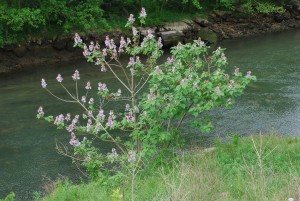Paulownia or Empress tree (Paulownia tomentosa) is a medium to large 30-50 foot tree. It is extremely fast growing, brittle wooded tree, as much as 4 feet per year. Across the Southern Appalachian region (USDA zones 6 and 7), the large pale violet flowers of paulownia are easily visible in May, perched on branch tips.
Its enormous 10-12 inch large medium green leaves are pushing out at the same time. The leaves dump considerable litter beneath the tree in the fall. Fall foliage color is of little importance.
Paulownia is an exotic from China which many plant experts have labelled “invasive”. A large paulownia tree produces many thousands of viable seeds which are dispersed by wind. The seeds are very susceptible to damping off disease (Pythium) and many do not survive. Seeds do germinate on “sterile” soil such as recently cleared ground and burned areas.
Paulownia is rarely seen in open fields already containing vegetation, compared to other serious invasives such as tree-of-heaven, privet, honeysuckle, et.al. It may grow on the edge of forests, but does not survive or compete in woodland shade.
Paulownia wood is highly prized by the Japanese for furniture, cooking utensils, owls, etc. There are several growers in the Southeastern U.S. who grow the fast growing paulownia wood for its export value.


 Posted in
Posted in 
